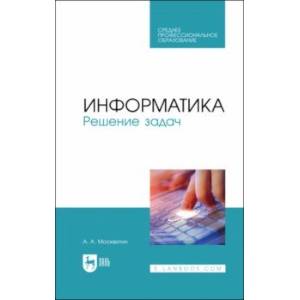Informatics. Solving problems. Textbook for SPO
Please sign in so that we can notify you about a reply
The textbook is designed for students of secondary specialized education specializing in the Computer Science.
At the heart of the textbook is a specific approach in computer science, based on the concept of a meaningful task for the user and a “modular program for teaching computer science” prepared by UNESCO.
The manual discusses all the stages of solving the problem on the computer - starting with setting a meaningful problem, developing the algorithm, specification, developing the interface, choosing an tool for encoding, testing and debugging a software tool, ending with the development of documentation, implementation and accompanying a software tool. In conclusion, an algorithm for evaluating the intellectual resources of users and their compliance with intellectual needs (solved tasks) is presented.
Having become acquainted with the material, the students will acquire both theoretical knowledge and practical skills, and this will develop the skills necessary for the exact setting of the task, develop an effective algorithm, choose the optimal software development environment, create a reliable software tool, test and debug it Its, as well as make the documentation necessary for the user and the customer.
The material of the training manual contains a rich set of illustrative material and is based both on the original works of the author and on the works of prominent scientists A.I. Maltsev, Yu.L. Ershova, E.A. Zhogoleva, S.S. Lavrova, N. Virta, D. Poaa, I. Lakatos, G. Mayers, E. Deikstra, D. Knuta, A.L. Bruchny and others, as well as on materials posted in the public domain
At the heart of the textbook is a specific approach in computer science, based on the concept of a meaningful task for the user and a “modular program for teaching computer science” prepared by UNESCO.
The manual discusses all the stages of solving the problem on the computer - starting with setting a meaningful problem, developing the algorithm, specification, developing the interface, choosing an tool for encoding, testing and debugging a software tool, ending with the development of documentation, implementation and accompanying a software tool. In conclusion, an algorithm for evaluating the intellectual resources of users and their compliance with intellectual needs (solved tasks) is presented.
Having become acquainted with the material, the students will acquire both theoretical knowledge and practical skills, and this will develop the skills necessary for the exact setting of the task, develop an effective algorithm, choose the optimal software development environment, create a reliable software tool, test and debug it Its, as well as make the documentation necessary for the user and the customer.
The material of the training manual contains a rich set of illustrative material and is based both on the original works of the author and on the works of prominent scientists A.I. Maltsev, Yu.L. Ershova, E.A. Zhogoleva, S.S. Lavrova, N. Virta, D. Poaa, I. Lakatos, G. Mayers, E. Deikstra, D. Knuta, A.L. Bruchny and others, as well as on materials posted in the public domain
Author:
Author:Moskvitin Anatoly Alekseevich
Cover:
Cover:Hard
Category:
- Category:Computer & Technology
Series:
Series: Computers and Software
ISBN:
ISBN:978-5-8114-8008-1
No reviews found
